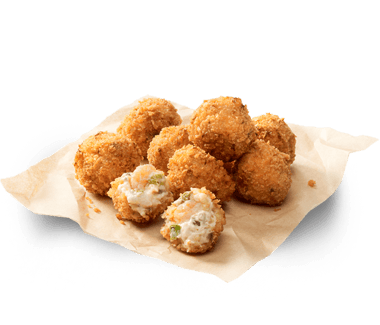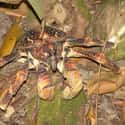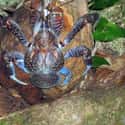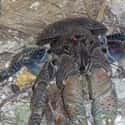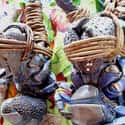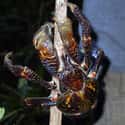-
(#1) Darwin Called Them "Monstrous"
Life is good for the coconut crab. Found on tropical islands around the Indian Ocean and parts of the Pacific, these terrestrial critters can live anywhere from 30 to 60 years. Their days consists of napping in shady corners, looking for shiny object, and of course, finding coconuts to eat, which is their favorite food.
They are the world's largest arthropods, a phylum of joint-legged creatures that also includes spiders, crustaceans, and other insects. Although the Japanese spider crab is technically larger, it lives underwater where it's weight is supported.
Apparently their overall size and strength of the coconut crab is so stunning, even Charles Darwin doubted the stories of the locals while visiting the Keeling Islands off the coast of Sumatra in 1836. He believed the natives were playing a trick on him until he finally glimpsed one for himself. Although their shell color can vary, they typically range from orangish-red to purplish-blue.
-
(#2) They Have A Lot Of Powerful Legs And Can Lift Up To 60 Pounds
Like all other crustaceans of its class, the body of a coconut crab is divided into different parts. The front section, called the cephalothorax, has 10 legs and an abdomen. The two front legs have powerful claws, followed by two pairs of strong walking legs with pointed tips. This combination allows them to adeptly climb vertical surfaces, including trees.
The fourth pair of smaller legs have tweezer-like claws for more precise actions like mating, tending to eggs, or making a nest. As for their large front claws, they are capable of lfting vegetation or rocks weighing up to 60 pounds.
-
(#3) They Can Eat Cats, Chickens, Birds, And Sometimes They Auto-Cannibalize
Despite its intimidating size, the robber crab is more of an opportunist than a predator. While it has been known to eat more sizable delicacies like chickens, kittens, and carrion birds, it tends to scavenge only what has been left behind. In 2017, people caught the coconut crab attacking a live bird for the first time.
The coconut crab is also one of the few creatures who self-cannibalize by eating others like themselves as well as their very own exoskeleton once it is sloughed off in the molting process. Experts believe this practice provides a great deal of calcium for creatures' astounding growth.
They also believe the coconut crab has only recently, through the evolutionary process, developed the ability to crack coconuts, a practice which allows them to eat less of their own kind.
-
(#4) Did They Eat Amelia Earhart?
There is a certain mystique about the coconut crab, mostly because of its extreme size and strength. Because of this, the creature has a certain mythical lore about it. One such example is the theory it is somehow linked to the historical disappearance of Amelia Earhart, who fell off the radar while flying her plane over the Pacific Ocean in 1937. Just three years later, researchers discovered a piece of bone on an island in the area which seemed to match the location and condition of those belonging to the missing pilot.
A theory soon emerged she had likely perished somewhere on this stretch of beach, possibly through an encounter with the frightening coconut crab. One hypothesis asserts she may have overwhelmed by the creatures as she lay unconscious and never able to recover.
To test this idea, researchers carried out an experiment using small pig carcasses. When they left the remains in the open, the crabs quickly picked them apart and scattered them around, similar to the way the alleged bones of Earhart were found. Although there is no way to be sure, it's entirely possible either her body or that of another stranded soul found its way into the claws of the robber crab, never to be seen again. One thing is for sure, however - coconut crabs love to feast on bones, pick them clean, and scuttle them away to their nests.
-
(#5) Their Claw Is Incredibly Powerful
While the thought of a nine pound crab falling out of the sky is enough to induce hyperventilation in some people, there are those who still like to mess with them. But it doesn't come without a price. If they manage to grasp on to a finger or a toe, it's likely they will snap the bone in two pieces. They also love holding onto things. If a crab has its claw wrapped around a coconut or a tree, it's holding on with an extremely firm grip.
As a result, natives of Micronesia have developed a method for lulling a coconut crab into a tranquil state so they will loosen their grip. By tickling the softer under parts of its body with a light branch or material can often be enough to lull the crab into letting go of what it is holding.
-
(#6) They Can Break Into Coconuts With Their Claws
These great omnivores enjoy many different foods, although they number favorite is, of course, coconuts. Despite the notoriously tough outer shell, these tenacious crabs begin by tearing the husk, fiber by fiber, until it the hairy outside is completely removed. This can take several hours or even days. The task was so arduous researchers once believed it likely wasn't even possible for the crab to do it at all until they witnessed it first-hand.
They use their hammer-strong claws to dig into one of the "eye holes" until there is an opening, and suck out the liquid before cracking the whole thing open to eat the tender, white meat inside, which makes up the majority of their diet. Their great size has been attributed to this plentiful food source, although the crabs also feed on a variety of other protein-rich items.
They use their extremely well-developed sense of smell to find all sorts of beach goodies and will eat basically any organic matter they come across, or at least ferry it away for heavier inspection. The crab is typically a nocturnal eater, grabbing rotted fruit, pith from fallen trees, and any other morsels are often discovered under the cover of darkness.
-
(#7) They Can Grow To Be Enormous
Like others of their kind, coconut crabs begin their lives in the sea, floating freely and eating until they find the perfect shell to adopt. Once they establish their portable home, they can begin their transition to live on land. Although the shell is comfortable and safe, it soon becomes too small for the crab, and they are forced to venture out to find a new one with more room. After about a year of moving from shell to shell, the coconut crab must embrace its true nature of being the biggest, baddest arthropod in the world.
And like the Incredible Hulk, it breaks free from its restraints and emerges as a fiercer, stronger creature. The parts of its body that were once protected quickly harden through a process of recalcification, and the crab is free to become ginormous.
-
(#8) People Catch Them And Eat Them
Of course, there are plenty of people crazy enough to catch a coconut crab, a feat that could easily cost them a finger if not done properly. By grabbing the two longest legs, just behind their two massive front claws, and pinning them together, it is possible to pick one up pretty easily. Or at least it looks easy. Sort of. Ok, not really.
Pacific islanders have been catching them for years and consider them to be a delicacy and an aphrodisiac. Apparently, coconut crabs taste very similar to lobster or regular crab meat. The fat in the abdomen and the eggs inside the female are considered the most delicious parts, and they can be prepared by steaming or boiling them, preferably in coconut milk.
Although the crab is not known to be poisonous, it is believed they can become toxic after eating certain plants for a long period of time. That said, they are generally not sold or eaten on a normal basis. In fact, eating a coconut crab on Christmas Island is a $5,500 fine.
-
(#9) They Are Grouchy
Coconut crabs do not enjoy visitors. They are known to burrow deep into the cool sand beneath the roots of trees as a way to hide from the sun, and will even avoid crabs of their own kind. They will aggressively defend their territory if challenged - especially if there's any food involved. When they emerge, their temperament is not much better, and they are largely keep their distance from one another.
To announce their presence, they will wave their large claws around in warning and scuttle around any other crabs they see. Decidedly unsocial creatures (unless it's mating season), coconut crabs live solitary lives - and like it just fine that way.
-
(#10) They Could Become Endangered
Despite their curious appearance and behavior, not a great deal is known about the coconut crab or whether they are in danger of become extinct. While there's no doubt they are tough critters with an incredible ability to adapt, they may be vulnerable to the biggest predator of all - humans. Even though their overall habitat is relatively small, their total population has yet to be calculated by researchers, who have categorized them as "Data Deficient," meaning they are still trying to determine their population's status.
Some conservation efforts have implemented strategies to protect them from humans by limiting the number of crabs taken by hunters and enforcing a strict licensing process.
-
(#11) They Have A Strange Relationship With The Sea
Unlike most crabs, this giant creature has adapted so well to life on land, it will drowned if left too long in water. Although it has modified gills surrounded by spongy tissue that must be kept moist, it achieves this through dipping its legs in the sea and sprinkling itself. It may drink some sea water to maintain its salt balance and of course, the females return to the ocean when they release their fertilized eggs.
The resulting larvae are planktonic for about a month - drifting freely around with other tiny organisms - until they settle on the sea floor and find their first gastropod shell.
-
(#12) They Have A Crazy Sense Of Smell
Everything the coconut crab is attracted to is found by its sense of smell. Typically, it won't approach anything unless it gets a whiff of something edible. Unlike most other crabs, they live on land and therefore have specially shortened antennae to detect smells in the air over great distances.
Their olfactory system is the most well developed part of the crab's brain and is immediately drawn to smells of potential food sources like rotting meat, fruit, or coconuts.
-
(#13) They Fall From Trees
One of the most curious things about the coconut crab is its ability to crack open coconuts through climbing trees. Once the husk is removed, the crab can grip the remaining nut in its claws and climb a tree up to 33 feet high, dropping it from the top so it will crack on the ground below. This makes it easier to access the nutty deliciousness inside without too much labor. Climbing down is not quite as easy, however, and they often choose to free fall if the drop is not more than about 15 feet.
For those who find the coconut crab to be somewhat alarming, this reality can cause a paralyzing fear of walking through a tropical coconut grove where these crabs are known to live.
New Random Displays Display All By Ranking
About This Tool
As we all know, the coconut crab is the largest terrestrial arthropod and terrestrial crab. But you must not be fooled by its title. In fact, the natural habitat of coconut crabs is often in tropical woods not far from the sea, and the larvae produced by the breeding pair need to grow in the sea environment. Therefore, the Western Pacific and the entire Indian Ocean are their most common places of residence.
The coconut crabs are huge and anti-social, they will steal your silverware and can tear the whole coconut with their claws. It is a great time to know more about this shocking animal, the random tool introduced 13 facts about the coconut crab that many people do not know.
Our data comes from Ranker, If you want to participate in the ranking of items displayed on this page, please click here.

